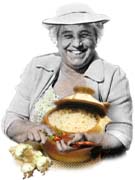|

Spices and spice mixtures by Claudia Roden*
Sephardi communities are known for the wide range of aromatic
herbs, seeds, bark, roots, pods, pistils, petals, flower waters, and oil they
use. Every community has its favorites. Where one uses saffron, another uses
turmeric. Cumin and coriander are favorites of Egyptian Jews, allspice and cinnamon
are much used by the Turks, and cardamom is popular with Iraqis and Indians.
Tamarind goes into sweet-and-sour foods of families originating in Syria, Persia,
Iraq and India, and sour pomegranate syrup has the same role with people from
Persia and Syria.
Where North African Jews use orange-blossom water, Turkish and
Balkan Jews use rose water. Grated orange zest, chocolate, and vanilla are a
sign of Iberian ancestry. The sharp red berries of the sumac tree; mastikah
(mastic), the resin of the acacia tree; and sahlab, the ground bulb of
a type of orchid, are a sign of roots in the Arab world. Each community used
all the aromatics of its locality, but in a slightly different way from the
general population, so that the food tasted a little different.
Spice mixtures suitable for certain kinds of dishes were common.
Ready made ones were sold at the bazaar, but Jews made their own, in case tiny
insects had invaded a batch, or because of something that was not kosher —
such as the golden beetle in the ras el hanout mixture of North Africa. They
bought fresh whole spices and roasted and pounded them themselves. Nowadays
in many homes you still find two or three jars of ground mixed spices in the
larder.
In Egypt (where I grew up) we used a combination of cinnamon,
nutmeg, cloves and all spice, which we called quatre epices (four spices). Za’tar,
a mixture of wild thyme [or hyssop leaves], roasted sesame seeds, the ground
sour red berries of the sumac tree, and salt, has become very popular in Israel,
where it is eaten with bread dipped in olive oil.
Kama is a Moroccan blend of black pepper, turmeric, ginger, cumin and nutmeg
used for stew and soups. Hawaij, a Yemeni ground spice mixture famous in Israel
and used in meat dishes and soups, is made up of black pepper, cardamom, saffron
and turmeric [more about Yemenite spice mixtures and recipes below]. The Aden
version has coriander, cumin, cardamom, and black pepper. Adenis also have a
mixture of ground cinnamon, cloves, and cardamom for their tea, which they drink
without milk, and a mixture of ginger, cardamom, cloves and cinnamon for their
black coffee.
Herbs and spices were also valued for their therapeutic and
medicinal qualities, as aphrodisiacs, and for magic purposes. People knew which
were good for digestion, which calmed the nerves and helped circulation, which
killed bacteria, increased the appetite, and acted as sexual stimulants. Garlic
was supposed to protect from the evil eye and evil spirits. The Jews of Turkey
were in the habit of hanging a head of garlic outside the door; when no one
in the community died during a cholera epidemic, Muslims said it was the stench
of garlic that had kept away the bacteria.

|
Habibe Krief, Tunisia, 1956. Habibe, the grandmother
of Orit Kariv-Manor, is pictured here with a ceramic pot of couscous.
|
|
| Yemeni spice mixtures
and recipes by Joan Nathan** |
In addition to hawaij, Yemenite Jews enjoy a spicy sauce
called helbeh (in Arabic) or rubiya (in Hebrew), meaning "be
fruitful and multiply." The sauce is made from soaked fenugreek seeds, which
symbolize fertility. According to a Yemenite legend, fenugreek is supposed to
keep women plump and fertile. The fenugreek is combined with fresh tomatoes and
zhug, the Yemenite combination of pepper, black caraway seed, cumin, cardamom
pods, garlic, fresh coriander, and dried chili pepper (see recipe).
Hot spice combinations such as the zhug and hawaij are as important
to Yemenite cuisine, as sauces are to the French.
We
include here three basic recipes:
HAWAIJ: Yemenite spice
combination
HELBEH dipping sauce
made from fenugreek seeds and zhug
YEMENITE ZHUG: ground spices with herbs
|
 *
The Book of Jewish Food: An Odyssey from Samarkand to New York
(with more than 800 Ashkenazi and Sephardi recipes) by Claudia Roden (New
York: Alfred A. Knopf, 1997). Reprinted by permission of the publisher.
[back] *
The Book of Jewish Food: An Odyssey from Samarkand to New York
(with more than 800 Ashkenazi and Sephardi recipes) by Claudia Roden (New
York: Alfred A. Knopf, 1997). Reprinted by permission of the publisher.
[back]
 **
The Holiday Kitchen. New York: Schocken Books 1988. Reprinted by permission
of the publisher. [back] **
The Holiday Kitchen. New York: Schocken Books 1988. Reprinted by permission
of the publisher. [back]
|
|
Claudia Roden travels extensively as a food writer. She
has published several prize-winning books on cookery and received Italy’s
two most prestigious food prizes for her London Sunday Times Magazine
series “The Taste of Italy.”
Joan Nathan has written widely on Jewish ethnic and holiday
cooking, sharing recipes from around the world in both her books and her
special feature articles in The New York Times and Gourmet.
|
|
Top
photo: Archive Gerard Silvain |
|